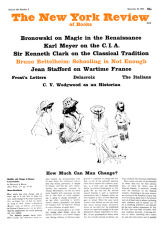In response to:
Art and Society Again from the June 11, 1964 issue
To the Editors:
The “superficial approach” by which Mr. Francis Haskell says my book Art, Artists and Society “is marred” is a comparative, cross-cultural, developmental approach familiar to anthropologists, sociologists, and psychologists. Asserting that the book is “cursory” and not “serious,” he removes examples from their context and sometimes falls into error himself. In his opening expression of boredom with discussions of the estrangement between “Art” and “Society,” he places their origin in the second half of the eighteenth century, though they occur already in Plato’s Republic. Later he ridicules my use of Delacroix’s portrait of George Sand as an illustration of the Romantic artist’s tendency to paint “solitary figures isolated from easy human contacts” but he omits the words following: “or enveloped in their thoughts. Delacroix painted George Sand in 1838 with severely heavy coiffure and shadows that weigh down her profile, serving to cast her glance inward. Even groups of people are often shut off from the outside world and partially obscured from one another….” The fact that in the original canvas Chopin also appeared in no way disproves the observation that people can feel lonely or sad even when not alone. Although, as Mr. Haskell says, Géricault’s Raft of the Medusa was not finally bought by the state until after his death, the director of the royal museums had arranged for it to be purchased by the government but Géricault, dissatisfied with its handling, reclaimed it (Henry Lachever, Détails intimes sur Géricault, 1870). Mr. Haskell neglects to mention that I specify (p. 127), “David did not show the rape in his painting of the Sabine Women (Louvre), using instead the part of the story which shows reconciliation between the warring parties…” Mr. Haskell attacks out of context a clearly metaphorical remark about the early eighteenth-century French aristocracy “crumbling”—a reference to changes within the nobility to which many historians trace some of the origins of the French Revolution. He does not indicate that I include many less familiar along with well-known painters and paintings. He also fails to mention that I discuss in detail the taste for inimate as well as grandiose pictures. Throughout I try to demonstrate, concretely and theoretically, the complexity of the relationships between and within social classes, art styles, and individual artists, as “part of a grand debate that may have no end.”
Geraldine Pelles
New York City
Francis Haskell replies:
Far from being bored with discussions of the subject of Miss Pelles’s book, I wrote that a serious examination of the phenomenon that concerns her “would be one of the most valuable contributions that could possibly be made to the History of Modern Art.” My estimate of her superficiality of approach is hardly refuted by her claiming that it is familiar to anthropologists, sociologists and psychologists. Alas, this is probably true—but scarcely to the point. I singled out four errors. Of these, one (about the relations of Fragonard and Greuze to the Academy) has been tacitly acknowledged by Miss Pelles; one (about Géricault) is also accepted by her although she makes some qualifications based on a late writer whose story conflicts with that of the reliable Clément, the main authority on the artist, and also with the apparent implications of Géricault’s own letters. Of the other two, although it is true that she recognizes that David did not show the actual rape of the Sabines, the passage she quotes in her letter occurs more than twenty pages after she has maintained that “people interpreted the Rape of the Sabine Women…as symbolic of the need for reconciliation after the Terror”—a sentence which clearly makes nonsense.
Finally Delacroix’s portrait of George Sand: textual analysis would be tedious here, but I challenge anyone to read the relevant paragraphs on page 11 and realize from them that the original picture represents a pair of lovers.
I still do not understand why the aristocracy was “crumbling” (either “in reality,” as Miss Pelles says in her book, or “metaphorically,” as she now claims) at the beginning of the 18th century. Who are the Historians who trace the origins of the French Revolution to a change of this kind? This is just the sort of judgment (and there are many similar ones) that I call “superficial” in my review—but I would be genuinely sorry if what I wrote there should discourage people from reading a book in which, as I also pointed out, there are some interesting quotations and illuminating inghts.
This Issue
September 10, 1964



